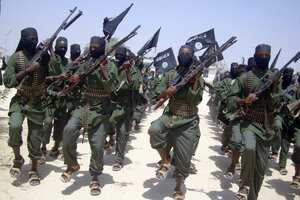Failed Navy SEALs raid on Somali target could bolster Al Shabab
Past US strikes on Al Shabab leaders, even successful ones, have not diminished the group.

Al Shabab fighters march with their weapons during military exercises on the outskirts of Mogadishu, Somalia in February 2011. Foreign military forces carried out a pre-dawn strike Saturday, against foreign fighters in the same southern Somalia village where US Navy SEALS four years ago killed a most-wanted al-Qaida operative, officials said.
Mohamed Sheikh Nor/AP/File
Mombasa, Kenya
A commando unit from the US Navy’s Seal Team Six launched an amphibious raid on a Somali town, but failed to confirm a capture or kill of their Al Shabab target, suspected to be linked to Nairobi’s Westgate mall terror attack.
The operation could have opposite its intended result of discouraging further attacks. Analysts warn that even earlier successful targeted strikes against Al Shabab, a Somalia-based Islamist militant group, failed to curb the group's capacity to carry out international terror attacks, and that failed missions could in fact bolster its support and recruitment.
The predawn raid Saturday came unstuck when the US troops were faced with heavier-than-expected return fire, and pulled out to avoid civilian casualties, two security sources said. No Americans were injured.
Although the target was not named and officially described only as “high-value,” US officials suggested the raid was “prompted by Westgate”.
Saturday’s mission took place in Baraawe, an Al Shabab stronghold 110 miles south of Mogadishu, where US Special Forces carried out a daytime raid in 2009 to kill Saleh Ali Saleh Nabhan, wanted in connection with earlier terrorist strikes in East Africa.
In Saturday's raid, the commandos came ashore in speedboats and immediately focused their assault on a beachside villa where it is understood that the target had been staying, the Associated Press reported.
However a dozen Al Shabab fighters returned fire and threw grenades, a source in Mogadishu says, and the Seals’ commanders made the call to pull out to avoid civilian casualties. Helicopter gunships launched from military vessels offshore arrived to provide cover for the retreating troops, according to reports from eyewitnesses.
The target building was known as a safe house for foreign fighters who had traveled to Somalia to fight with Al Shabab. Ahmed Godane, also known as Mukhtar Abu al-Zubayr and the leader of the group’s hardline faction that claimed responsibility for the Nairobi shopping center attack, had stayed there before but it was not clear how recently.
Several Somali news sites claimed that Godane was in a nearby house but escaped, although these reports could not immediately be verified.
The US Rewards for Justice program offers a $7 million reward for information about his whereabouts. US officials in Nairobi who spoke to the Monitor, and government spokesmen in Washington, refused to confirm or deny that Godane was the raid’s target. An Al Shabab spokesman did not return emails for comment Sunday.
Several senior Al Shabab or Al Qaeda commanders have been killed in targeted strikes inside Somalia in recent years, including Mr. Nabhan.
Fazul Mohammed, Al Qaeda’s leader in East Africa who was accused of masterminding the bombings of US embassies in Kenya and Tanzania, died at a Mogadishu roadblock in 2011.
“There is an obvious reason to take these guys out, but it’s been done and still you get Shabab being capable of arranging, or helping to arrange, Westgate,” says one Western security source in Nairobi who spoke anonymously because of their employer’s restrictions on speaking to the press.
“Shabab is constantly shifting. There are leaders on the ground, then guys who are kind of advisors, guys with experience of bomb-making and guerrilla tactics," he says. “If you kill one, there’s another to take over. Godane, if he was the target, would have been a big kill, but the increasingly hardline of his faction in Shabab would bounce back.”
The way that the Westgate attack took days to resolve, coupled with the failure of the US team Saturday to capture their target, would allow Al Shabab to “boast of its power” and attract new recruits, the source adds.

